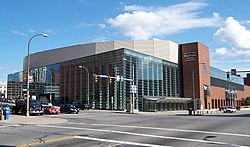Rochester Community War Memorial
 |
|
| Full name | Blue Cross Arena at the War Memorial |
|---|---|
| Former names | Rochester Civic Center Arena (planning/construction) Rochester Community War Memorial (1955–1998) |
| Location | 1 War Memorial Square Rochester, New York 14614-2109 |
| Owner | City of Rochester |
| Operator | SMG |
| Capacity |
Basketball: 11,385 *End stage 180°: 11,268 *End stage 270°: 11,629 *End stage 360°: 12,819 *Center stage: 12,876 *Theatre: 8,781 |
| Construction | |
| Broke ground | February 1, 1953 |
| Opened | October 18, 1955 |
| Construction cost | US$7.5 million ($67.1 million in 2017 dollars) $41 million (1998 renovations) ($62.6 million in 2017 dollars) |
| Architect | Leonard A. Waasdorp |
| Tenants | |
|
Rochester Royals (NBA) (1955–57) Rochester Americans (AHL) (1956–present) Rochester Griffins (NLL) (1974) Rochester Lancers (NASL) (1975) Rochester Knighthawks (NLL) (1995–present) Rochester Brigade (af2) (2001–03) Rochester Razorsharks (PBL) (2005–present) Rochester Raiders (IFL) (2008–09) Rochester Lancers (MISL/MASL) (2011–15) Atlantic Hockey tournament (2007–present) RIT Tigers men's ice hockey (NCAA) (select games) St. Bonaventure Bonnies men's basketball (NCAA) (select games) |
|
| Website | |
| Venue Website | |
Basketball: 11,385
Ice Hockey: 10,664
Blue Cross Arena (originally Rochester Community War Memorial and commonly the War Memorial) is a multi-purpose indoor arena located in Rochester, New York. Its maximum seating capacity is 13,000. For hockey and lacrosse, its seating capacity is 11,200.
The arena opened on October 18, 1955, as the Rochester Community War Memorial, it was renovated in the mid-1990s and reopened as The Blue Cross Arena at the War Memorial, on September 18, 1998.
It is home to the Rochester Americans of the AHL, the Rochester Razorsharks of the PBL, and the Rochester Knighthawks of the NLL.
The arena was built on a downtown site as a replacement for Edgerton Park Arena, bounded by Exchange Boulevard on the west, East Broad Street on the north, the Genesee River on the east and Court Street on the south. The property was formerly the home of the Kimball Tobacco Co. and other retail buildings. Originally named the Rochester Community War Memorial, the arena opened on October 18, 1955. The building included a full stage on the south end and an exhibition hall located on the basement level. One of the members of the construction team was a young Robert Marella, who later achieved fame as a professional wrestler under the ring name Gorilla Monsoon.
On March 13, 1996, renovations to expand the arena took place, eliminating the permanent stage at the south end of the building. On July 24, 1998, Blue Cross Blue Shield and City officials announced that the name of the renovated arena would be Blue Cross Arena at the War Memorial. On September 18, 1998, the arena reopened to the public during a formal ribbon cutting/rededication ceremony. DeWolff Partnership Architects completed the project as Architects of Record with Rossetti Architects in a consultant relationship. C.E. DeWolff, Senior Partner of DeWolff Partnership, Geno Rossetti of Rossetti Architects, were Design Associates who collaborated on features of the design.
...
Wikipedia
